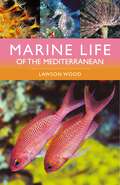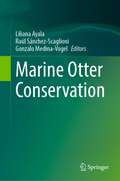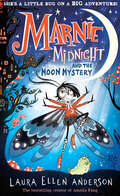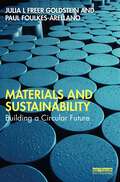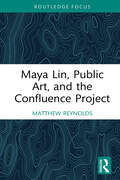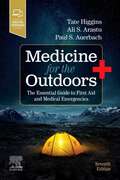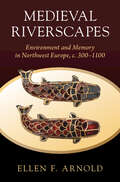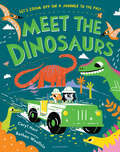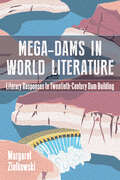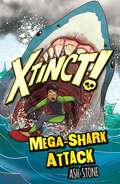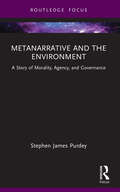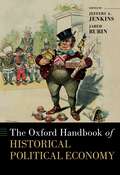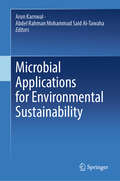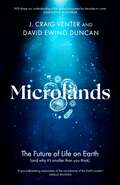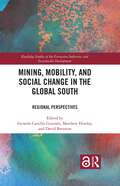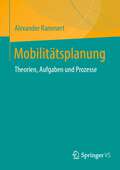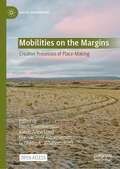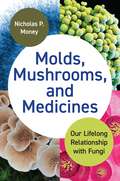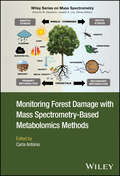- Table View
- List View
Marine Life of the Mediterranean
by Lawson WoodA new and updated edition of this popular title covering the fishes, invertebrates and other marine life of the Mediterranean Sea.Almost entirely enclosed by land, the Mediterranean Sea is surrounded by many popular wildlife destinations, including Spain, France, Italy, Malta, Gibraltar, Greece and Turkey. From sharks and turtles to algae and sponges, Marine Life of the Mediterranean reveals the fascinating wealth of sea life found in this diverse region. Featuring more than 290 species of fish, corals and other vertebrates and invertebrates, each species account includes key information on identification, habitats, diet and behaviour. Recommendations on where to go scuba diving, as well as important information on dangerous marine life, conservation zones and marine protected areas are also included. This compact and easy-to-follow guidebook – illustrated with colour photographs taken in a number of unique and exotic locations – is an essential companion for divers, snorkellers and underwater photographers visiting the area.
Marine Otter Conservation
by Liliana Ayala Raúl Sánchez-Scaglioni Gonzalo Medina-VogelThis book offers a multidisciplinary approach to conservation issues related to the marine otter (Lontra felina). The main goal is the systematization of different research efforts on this species, to contribute with conservation policy design and implementation. The authors contribute their achievements in conservation, ecology, status in freshwater habitats, habitat fragmentation effects, interaction with human activities and recommendations for an effective conservation of the species. The book is directed first and foremost towards researchers and authorities and people involved in conservation tasks of otters.Despite in the last decades some studies and efforts on Lontra felina has carried in Peru and Chile, some information can be gathered to fill the gaps on marine otter conservation in Peru. That is the main goal of the book Conservation of Marine Otter. Moreover, the publication will be the first book published at international level on Lontra felina with the participation of several experimented researchers on this threatened and endemic species.
Marnie Midnight and the Moon Mystery (Marnie Midnight #1)
by Laura Ellen AndersonA magical new young fiction series from best-selling author and illustrator, Laura Ellen Anderson!
Materials and Sustainability: Building a Circular Future
by Julia L Goldstein Paul Foulkes-ArellanoThis book examines sustainable manufacturing, from the extraction of materials to processing, use, and disposal, and argues that significant changes in all of the above are needed for the world to progress toward a more circular economy.Materials and processing methods are usually chosen with performance as the key metric. Why has our society embraced plastics? Because they work. In most cases, they are lighter, easier to manufacture, and less expensive than the metal, wood, glass, or stone they have replaced. Why do industrial manufacturers use toxic chemicals? Because they are effective, but the unintended consequences may be severe. By learning how various materials are made and what happens when they are recycled, readers will better understand the value of materials and the challenges that manufacturers face when trying to make their facilities and products less toxic and less wasteful. The three chapters in Part I provide essential background about materials in the circular economy, chemicals, and waste. Part II delves into specific materials. It includes chapters on plastics, metals, wood and paper products, glass, and novel materials. Part III covers recycling and manufacturing processes, and Part IV delves into practical considerations, including the effect of regulations, concluding with a chapter that helps readers translate the information presented into action. Interviews with industry experts round out the chapters and offer valuable insights.Materials and Sustainability is a must-read for business professionals who are serious about making their companies as environmentally responsible as possible and for business and engineering students who want to begin their careers with practical knowledge about materials and their impacts.
Materials and Sustainability: Building a Circular Future
by Julia L Goldstein Paul Foulkes-ArellanoThis book examines sustainable manufacturing, from the extraction of materials to processing, use, and disposal, and argues that significant changes in all of the above are needed for the world to progress toward a more circular economy.Materials and processing methods are usually chosen with performance as the key metric. Why has our society embraced plastics? Because they work. In most cases, they are lighter, easier to manufacture, and less expensive than the metal, wood, glass, or stone they have replaced. Why do industrial manufacturers use toxic chemicals? Because they are effective, but the unintended consequences may be severe. By learning how various materials are made and what happens when they are recycled, readers will better understand the value of materials and the challenges that manufacturers face when trying to make their facilities and products less toxic and less wasteful. The three chapters in Part I provide essential background about materials in the circular economy, chemicals, and waste. Part II delves into specific materials. It includes chapters on plastics, metals, wood and paper products, glass, and novel materials. Part III covers recycling and manufacturing processes, and Part IV delves into practical considerations, including the effect of regulations, concluding with a chapter that helps readers translate the information presented into action. Interviews with industry experts round out the chapters and offer valuable insights.Materials and Sustainability is a must-read for business professionals who are serious about making their companies as environmentally responsible as possible and for business and engineering students who want to begin their careers with practical knowledge about materials and their impacts.
Maya Lin, Public Art, and the Confluence Project (Routledge Focus on Art History and Visual Studies)
by Matthew ReynoldsThe first scholarly monograph devoted exclusively to this vital work of contemporary public art, this book examines Maya Lin’s Confluence Project through the lens of environmental humanities and Indigenous studies. Matthew Reynolds provides a detailed analysis of each earthwork, along with a discussion of the proposed final project at Celilo Falls near The Dalles, Oregon. The book assesses the artist’s longtime engagement with the region of the Pacific Northwest and explores the Confluence Project within Lin’s larger oeuvre. Several consistent themes and experiences are common amongst all the sites. These include an emphasis on individual, multisensory encounters with the earthworks and their surrounding contexts; sound as an experiential dimension of landscape; indexical accounts of the multicultural, multispecies histories of each place; and an evocation of loss. The book will be of interest to scholars working in art history, contemporary art, environmental studies, environmental humanities, and Native American studies.
Maya Lin, Public Art, and the Confluence Project (Routledge Focus on Art History and Visual Studies)
by Matthew ReynoldsThe first scholarly monograph devoted exclusively to this vital work of contemporary public art, this book examines Maya Lin’s Confluence Project through the lens of environmental humanities and Indigenous studies. Matthew Reynolds provides a detailed analysis of each earthwork, along with a discussion of the proposed final project at Celilo Falls near The Dalles, Oregon. The book assesses the artist’s longtime engagement with the region of the Pacific Northwest and explores the Confluence Project within Lin’s larger oeuvre. Several consistent themes and experiences are common amongst all the sites. These include an emphasis on individual, multisensory encounters with the earthworks and their surrounding contexts; sound as an experiential dimension of landscape; indexical accounts of the multicultural, multispecies histories of each place; and an evocation of loss. The book will be of interest to scholars working in art history, contemporary art, environmental studies, environmental humanities, and Native American studies.
Medicine for the Outdoors E-Book: The Essential Guide to First Aid and Medical Emergencies
by Paul S. Auerbach Tate Higgins Ali S. ArastuFor nearly 40 years, Medicine for the Outdoors: The Essential Guide to First Aid and Medical Emergencies has been the take-along manual of choice for anyone venturing into the mountains, forest, desert, or on water. This essential guide provides highly illustrated, easy-to-follow guidance on immediate stabilization and treatment of persons with virtually any possible medical problem—designed for on-the-spot use when higher-level medical care is not accessible. Written by experts in outdoor medicine, this updated edition helps you manage any situation until medical personnel can take over. Covers key information on a wide range of disorders related to specific environments, including natural disasters, high-altitude problems, water-related incidents, heat- and cold-related illnesses, and wildland fires. Provides easy-to-understand recommendations for dealing with animal attacks, venomous wildlife, wild plant and mushroom poisoning, minor and major medical problems, infectious diseases, water disinfection, and severe bleeding. Discusses key topics, including antibiotics, medicines, opioid overdose treatment, wound closure techniques, severe bleeding, spinal assessment and immobilization, tourniquets, the use of a Gamow bag for severe altitude illness, splinting, dental emergencies, disaster preparedness, global conflict guidelines, canine medicine, today’s infectious disease threats, and much more. Includes up-to-date guidelines, even more helpful illustrations and diagrams, and a new chapter: Patient Assessment: A Structured Approach to Emergencies in the Outdoors. Includes advanced topics valuable to physicians and expedition medical staff at all levels of training and experience.
Medieval Riverscapes: Environment and Memory in Northwest Europe, c. 300–1100 (Studies in Environment and History)
by null Ellen F. ArnoldFishermen, monks, saints, and dragons met in medieval riverscapes; their interactions reveal a rich and complex world. Using religious narrative sources to evaluate the environmental mentalities of medieval communities, Ellen F. Arnold explores the cultural meanings applied to rivers over a broad span of time, ca. 300-1100 CE. Hagiographical material, poetry, charters, chronicles, and historiographical works are explored to examine the medieval environmental imaginations about rivers, and how storytelling and memory are connected to lived experiences in riverscapes. She argues that rivers provided unique opportunities for medieval communities to understand and respond to ecological and socio-cultural transformations, and to connect their ideas about the shared religious past to hopes about the future.
Meet the Dinosaurs (Meet the . . .)
by Caryl HartZOOOOM! We're off on an exciting journey into the past to meet the amazing dinosaurs that once roamed the earth. Join in with the rhymes and get ready to spot all the friendly (and not so friendly!) dinosaurs, from the huge Brontosaurus and amazing Diplodocus to the speedy Velociraptor and scary T-Rex. Little ones will have an action-packed time (and be back in time for bed!) in this fun and fact-packed picture book. This bold, bright follow-up to the acclaimed picture books Meet the Planets, Meet the Oceans and Meet the Weather is filled with ALL your favourite dinos. Combining STEM learning with a rhyming twist, it's perfect for all would-be palaeontologists.
Mega-Dams in World Literature: Literary Responses to Twentieth-Century Dam Building
by Margaret ZiolkowskiMega-Dams in World Literature reveals the varied effects of large dams on people and their environments as expressed in literary works, focusing on the shifting attitudes toward large dams that emerged over the course of the twentieth century. Margaret Ziolkowski covers the enthusiasm for large-dam construction that took place during the mid-twentieth-century heyday of mega-dams, the increasing number of people displaced by dams, the troubling environmental effects they incur, and the types of destruction and protest to which they may be subject. Using North American, Native American, Russian, Egyptian, Indian, and Chinese novels and poems, Ziolkowski explores the supposed progress that these structures bring. The book asks how the human urge to exploit and control waterways has affected our relationships to nature and the environment and argues that the high modernism of the twentieth century, along with its preoccupation with development, casts the hydroelectric dam as a central symbol of domination over nature and the power of the nation state. Beyond examining the exultation of large dams as symbols of progress, Mega-Dams in World Literature takes a broad international and cultural approach that humanizes and personalizes the major issues associated with large dams through nuanced analyses, paying particular attention to issues engendered by high modernism and settler colonialism. Both general and specialist readers interested in human-environment relationships will enjoy this prescient book.
Mega-Shark Attack: Book 3 (Xtinct! #3)
by Ash StoneA Megaladon Shark comes back to life in this action-packed adventure story. When Jeevan gets caught in one of Barron Fox's fishing nets, he is pulled into a dangerous underwater adventure. But drowning is the least of his worries. An extinct animal has come back to life in the water ... a megaladon shark! Can Jeevan escape the jaws of the mega-shark and outwit Barron Fox's hunters?Perfect for fans of Beast Quest, Deadly 60 and Jurassic Park, these action-packed adventures will inspire readers to help save endangered species and combat extinction.
Metanarrative and the Environment: A Story of Morality, Agency, and Governance (Routledge Research in Environmental Policy and Politics)
by Stephen James PurdeyTo meet the challenge of global environmental degradation activists have tackled clear and concrete problems such as carbon emissions and climate change, the ruination of ecosystems and habitat, the precipitous loss of biodiversity, and many other unhappy consequences of irresponsible human behaviour. However, all such efforts to manually correct the course of history have been dwarfed by the magnitude and heavy forward momentum of modern industrial society. In Metanarrative and the Environment, Stephen James Purdey argues that material approaches to the environmental crisis cannot succeed without the power of a legitimating discourse – a new metanarrative – which fundamentally changes the ideational landscape of human development. Dr. Purdey begins in Part I by establishing the pragmatics of our environmental predicament – its roots and responses to it. He focuses on the concept, definition, and key features of metanarrative, introducing the hegemonic story that now rules the contemporary global mindscape. Part II takes on the moral problematic more directly, encouraging the evolution of a new metanarrative by bringing our potential for agency in the face of danger into sharper relief. Metanarrative and the Environment is multidisciplinary, with a particular emphasis on the creative humanities. It will be of interest to undergraduate and graduate students alike, as well as environmental activists and academics looking for a new way forward.
Metanarrative and the Environment: A Story of Morality, Agency, and Governance (Routledge Research in Environmental Policy and Politics)
by Stephen James PurdeyTo meet the challenge of global environmental degradation activists have tackled clear and concrete problems such as carbon emissions and climate change, the ruination of ecosystems and habitat, the precipitous loss of biodiversity, and many other unhappy consequences of irresponsible human behaviour. However, all such efforts to manually correct the course of history have been dwarfed by the magnitude and heavy forward momentum of modern industrial society. In Metanarrative and the Environment, Stephen James Purdey argues that material approaches to the environmental crisis cannot succeed without the power of a legitimating discourse – a new metanarrative – which fundamentally changes the ideational landscape of human development. Dr. Purdey begins in Part I by establishing the pragmatics of our environmental predicament – its roots and responses to it. He focuses on the concept, definition, and key features of metanarrative, introducing the hegemonic story that now rules the contemporary global mindscape. Part II takes on the moral problematic more directly, encouraging the evolution of a new metanarrative by bringing our potential for agency in the face of danger into sharper relief. Metanarrative and the Environment is multidisciplinary, with a particular emphasis on the creative humanities. It will be of interest to undergraduate and graduate students alike, as well as environmental activists and academics looking for a new way forward.
Microbes: The Unseen Agents of Climate Change
by David L. KirchmanFor billions of years, microbes have produced and consumed greenhouse gases that regulate global temperature and in turn other aspects of our climate. The balance of these gases maintains Earth's habitability. Methane, a greenhouse gas produced only by microbes, may have kept Earth out of a deep freeze billions of years ago. Likewise, variations in carbon dioxide, another greenhouse gas released by microbes and other organisms, help to explain the comings and goings of ice ages over the last million years. Now we face a human-made climate crisis with drastic consequences. The complete story behind greenhouse gases, however, involves microbes and their role in natural ecosystems. Microscopic organisms are also part of the solution, producing biofuels and other forms of green energy which keep fossil fuels in the ground. Other microbes can be harnessed to reduce the release of methane and nitrous oxide from agriculture, and geoengineering solutions that depend on microbes could pull carbon dioxide out of the atmosphere. In this book, David L. Kirchman introduces a unique and timely contribution to the climate change conversation and the part microbes play in our past, present, and future. He takes readers into the unseen world behind the most important environmental problem facing society today and encourages us to embrace microbial solutions that are essential to mitigating climate change.
Microbial Applications for Environmental Sustainability
by Arun Karnwal Abdel Rahman Mohammad Said Al-TawahaThis book focuses on the various applications of microorganisms for sustainable environment and the reduction of hazardous pollutants released in various forms, including xenobiotics, e-waste, pesticides, insecticides, plastic, heavy metals, paper waste, medical waste, textile dyes, and their impact on environmental and human health. The book involves a series of research reports that explain the application of microbes used to solve real-life issues raised due to changes happening in environment, including pollution, by covering applications, including the use of bacteria, fungi, microalgae and biofilm in the detection and degradation of crude oil, pesticides, dyes, e-waste, heavy metals and other pollutants. It also focuses on integrative strategies in the application of microbial nanomaterials for remediation of pollutant. This material will help environmental scientists and microbiologists to learn about existing environmental problems and suggest novel ways to control or contain their effects by employing various treatment approaches.
Microlands: The Future of Life on Earth (and Why It’s Smaller Than You Think)
by J. Craig Venter David Ewing Duncan'An epic travelogue, brimming with the excitement of discovery. With characteristic panache, Venter unveils the teeming array of bacteria, viruses, and eukaryotes that crowd our planet's oceans' - Siddhartha Mukherjee'This page-turner gives . . . the thrill of seeing our planet's largest universe through the brilliant, intrepid eyes of the scientist who has done more than anyone to unlock the secrets of life' - Martine Rothblatt'A tour de force . . . Venter has expanded biology's horizons. This book explores microbial life on a global scale, providing cutting-edge solutions to problems of environmental change' - Aristides Patrinos'A ripping tale . . . to revolutionize our understanding of our bodies, the oceans, and the planet' - Jack Gilbert'An exhilarating account of how creative science is accomplished' - Sir Richard J. Roberts'[A] fascinating tour of Planet Microbe' - Bill McKibben'Venter and Duncan expand our scope of what it means to be alive' - Jamie Metzl'Inspiring ... change[s] our ideas of how biology is done' - TelegraphUpon completing his historic work on the Human Genome Project in 2002, J. Craig Venter declared that he would sequence the genetic code of all life on earth. Thus began a fifteen-year quest to collect DNA from the world's oldest and most abundant form of life: microbes. Boarding the Sorcerer II, a 100-foot sailboat turned research vessel, Venter travelled over 65,000 miles around the globe to sample ocean water and the microscopic life within.In this book, Venter and science writer David Ewing Duncan tell the remarkable story of these expeditions and of the momentous discoveries that ensued-of plant-like bacteria that get their energy from the sun, proteins that metabolize vast amounts of hydrogen, and microbes whose genes shield them from ultraviolet light. The result was a massive library of millions of unknown genes, thousands of unseen protein families, and new lineages of bacteria that revealed the unimaginable complexity of life on earth. Yet despite this exquisite diversity, Venter encountered sobering reminders of how human activity is disturbing the delicate microbial ecosystem that nurtures life on earth. In the face of unprecedented climate change, Venter and Duncan show how we can harness the microbial genome to develop alternative sources of energy, food, and medicine that might ultimately avert our destruction.A captivating story of exploration and discovery, this book restores microbes to their rightful place as crucial partners in our evolutionary past and guides to our future.
Mining, Mobility, and Social Change in the Global South: Regional Perspectives (Routledge Studies of the Extractive Industries and Sustainable Development)
This volume focuses on how, why, under what conditions, and with what effects people move across space in relation to mining, asking how a focus on spatial mobility can aid scholars and policymakers in understanding the complex relation between mining and social change. This collection centers the concept of mobility to address the diversity of mining-related population movements as well as the agency of people engaged in these movements. This volume opens by introducing both the historical context and conceptual tools for analyzing the mining-mobility nexus, followed by case study chapters focusing on three regions with significant histories of mineral extraction and where mining currently plays an important role in socio-economic life: the Andes, Central and West Africa, and Melanesia. Written by authors with expertise in diverse fields, including anthropology, development studies, geography, and history, case study chapters address areas of both large- and smallscale mining. They explore the historical-geographical factors shaping mining-related mobilities, the meanings people attach to these movements, and the relations between people’s mobility practices and the flows of other things put in motion by mining, including capital, ideas, technologies, and toxic contamination. The result is an important volume that provides fresh insights into the social geographies and spatial politics of extraction. This book will be of great interest to students and scholars of mining and the extractive industries, spatial politics and geography, mobility and migration, development, and the social and environmental dimensions of natural resources more generally.
Mining, Mobility, and Social Change in the Global South: Regional Perspectives (Routledge Studies of the Extractive Industries and Sustainable Development)
by Gerardo Castillo Guzmán Matthew Himley David BreretonThis volume focuses on how, why, under what conditions, and with what effects people move across space in relation to mining, asking how a focus on spatial mobility can aid scholars and policymakers in understanding the complex relation between mining and social change. This collection centers the concept of mobility to address the diversity of mining-related population movements as well as the agency of people engaged in these movements. This volume opens by introducing both the historical context and conceptual tools for analyzing the mining-mobility nexus, followed by case study chapters focusing on three regions with significant histories of mineral extraction and where mining currently plays an important role in socio-economic life: the Andes, Central and West Africa, and Melanesia. Written by authors with expertise in diverse fields, including anthropology, development studies, geography, and history, case study chapters address areas of both large- and smallscale mining. They explore the historical-geographical factors shaping mining-related mobilities, the meanings people attach to these movements, and the relations between people’s mobility practices and the flows of other things put in motion by mining, including capital, ideas, technologies, and toxic contamination. The result is an important volume that provides fresh insights into the social geographies and spatial politics of extraction. This book will be of great interest to students and scholars of mining and the extractive industries, spatial politics and geography, mobility and migration, development, and the social and environmental dimensions of natural resources more generally.
Mobilitätsplanung: Theorien, Aufgaben und Prozesse
by Alexander RammertDieses Buch umfasst die wesentlichen Grundlagen einer praxisorientierten Mobilitätsplanung. Im Gegensatz zur Verkehrsplanung fokussiert sich die Mobilitätsplanung auf den Menschen als zentrale Figur der Verkehrsentwicklung und entwirft daraus neue Perspektiven für die Planung. Mobilitätsplanung löst damit die Abhängigkeit vom technischen Artefakt des Verkehrs und zielt stattdessen darauf ab, direkt die Möglichkeiten der Menschen zu verstehen und zu beeinflussen. Das Buch richtet sich somit an alle Akteure, welche die Mobilität der Menschen in unterschiedlicher Weise beeinflussen. Klassischerweise gehören hierzu alle Ebenen der Planungspraxis, von Ministerien bis hin zu kommunalen Verwaltungen und Planungsbüros. Aber auch politisch Entscheidungstragende, Unternehmen und zivilgesellschaftliche Akteure gehören zu den Adressaten dieses Buches, da sie maßgeblich an der zukünftigen Entwicklung von Mobilität und Verkehr mitwirken.
Mobilities on the Margins: Creative Processes of Place-Making (Arctic Encounters)
by Björn Thorsteinsson Katrín Anna Lund Gunnar Thór Jóhannesson Guðbjörg R. JóhannesdóttirThis open access book examines places on the margins and the dynamics through which a marginal position of a place is created. Specifically, it explores how places, mostly in sparsely populated areas, often perceived as immobile and frozen in time, come into being and develop through interference of everyday mobilities and creative practices that cut across the spheres of culture and nature as usually defined. Through fieldwork and case studies from areas in Iceland, Finland, Greenland, and Scotland, the book’s twelve chapters draw out the multiple relations through which places emerge, where people compose their lives as best they can with their surroundings. A special concern is to explore the links between travelling, landscape, and material culture and how places and margins are enacted through mobilities and creative practices of humans and other beings. The emphasis on mobility disturbs the perception of a place as a bounded entity and offers a useful and necessary understanding of places as mobile and fluid. Mobilities on the Margins is a novel and timely contribution to the exploration of human and more-than-human interactions in a world of increasingly fluid mobilities and insistent crises.
Molds, Mushrooms, and Medicines: Our Lifelong Relationship with Fungi
by Nicholas P. MoneyThe hidden role of fungi inside and all around usFrom beneficial yeasts that aid digestion to toxic molds that cause disease, we are constantly navigating a world filled with fungi. Molds, Mushrooms, and Medicines explores the amazing ways fungi interact with our bodies, showing how our health and well-being depend on an immense ecosystem of yeasts and molds inside and all around us.Nicholas Money takes readers on a guided tour of a marvelous unseen realm, describing how our immune systems are engaged in continuous conversation with the teeming mycobiome inside the body, and how we can fall prey to serious and even life-threatening infections when this peaceful coexistence is disturbed. He also sheds light on our complicated relationship with fungi outside the body, from wild mushrooms and cultivated molds that have been staples of the human diet for millennia to the controversial experimentation with magic mushrooms in the treatment of depression.Drawing on the latest advances in mycology, Molds, Mushrooms, and Medicines reveals what scientists are learning about the importance of fungi to our lives, from their vital role in supporting the ecosystems on which we depend to their emerging uses in lifesaving medicine.
Molds, Mushrooms, and Medicines: Our Lifelong Relationship with Fungi
by Nicholas P. MoneyThe hidden role of fungi inside and all around usFrom beneficial yeasts that aid digestion to toxic molds that cause disease, we are constantly navigating a world filled with fungi. Molds, Mushrooms, and Medicines explores the amazing ways fungi interact with our bodies, showing how our health and well-being depend on an immense ecosystem of yeasts and molds inside and all around us.Nicholas Money takes readers on a guided tour of a marvelous unseen realm, describing how our immune systems are engaged in continuous conversation with the teeming mycobiome inside the body, and how we can fall prey to serious and even life-threatening infections when this peaceful coexistence is disturbed. He also sheds light on our complicated relationship with fungi outside the body, from wild mushrooms and cultivated molds that have been staples of the human diet for millennia to the controversial experimentation with magic mushrooms in the treatment of depression.Drawing on the latest advances in mycology, Molds, Mushrooms, and Medicines reveals what scientists are learning about the importance of fungi to our lives, from their vital role in supporting the ecosystems on which we depend to their emerging uses in lifesaving medicine.
Monitoring Forest Damage with Mass Spectrometry-Based Metabolomics Methods (Wiley Series on Mass Spectrometry)
by Dominic M. Desiderio Joseph A. LooMonitoring Forest Damage with Mass Spectrometry-Based Metabolomics Methods Understand forest responses to climate change with this timely introduction Forests are among the most critical parts of our global ecosystem, responsible for the air we breathe, home to most of the earth’s species, and crucial sources of food and raw materials. Forest development is therefore one of the most important areas of ecological study, and damage to forests is potentially existential. Metabolomics, a toolkit which accrues data on interactions between genetic and environmental conditions, promises to advance our understanding of how these vital ecosystems respond to dramatic changes in climate and environment. Monitoring Forest Damage with Mass Spectrometry-Based Metabolomics Methods offers a thorough, accessible discussion of metabolomic techniques and their applications in forest tree research. It promises to enrich the reader’s understanding of how forests are being transformed by globe-spanning changes, and to arm researchers with tools for reacting to these potentially epochal developments. Monitoring Forest Damage with Mass Spectrometry-Based Metabolomics Methods readers will also find: Analysis of specialized secondary metabolites such as phytohormonesDetailed discussion of ecologically important tree genera such as Pinus, Populus, Quercus, and many moreSupplementary materials related to study design, sample preparation, and instrumental analysis protocols Monitoring Forest Damage with Mass Spectrometry-Based Metabolomics Methods is ideal for researchers in analytical chemistry, mass spectrometry, metabolomics, forest research, the life sciences, and all other related fields.
Monitoring Forest Damage with Mass Spectrometry-Based Metabolomics Methods (Wiley Series on Mass Spectrometry)
by Dominic M. Desiderio Joseph A. LooMonitoring Forest Damage with Mass Spectrometry-Based Metabolomics Methods Understand forest responses to climate change with this timely introduction Forests are among the most critical parts of our global ecosystem, responsible for the air we breathe, home to most of the earth’s species, and crucial sources of food and raw materials. Forest development is therefore one of the most important areas of ecological study, and damage to forests is potentially existential. Metabolomics, a toolkit which accrues data on interactions between genetic and environmental conditions, promises to advance our understanding of how these vital ecosystems respond to dramatic changes in climate and environment. Monitoring Forest Damage with Mass Spectrometry-Based Metabolomics Methods offers a thorough, accessible discussion of metabolomic techniques and their applications in forest tree research. It promises to enrich the reader’s understanding of how forests are being transformed by globe-spanning changes, and to arm researchers with tools for reacting to these potentially epochal developments. Monitoring Forest Damage with Mass Spectrometry-Based Metabolomics Methods readers will also find: Analysis of specialized secondary metabolites such as phytohormonesDetailed discussion of ecologically important tree genera such as Pinus, Populus, Quercus, and many moreSupplementary materials related to study design, sample preparation, and instrumental analysis protocols Monitoring Forest Damage with Mass Spectrometry-Based Metabolomics Methods is ideal for researchers in analytical chemistry, mass spectrometry, metabolomics, forest research, the life sciences, and all other related fields.
